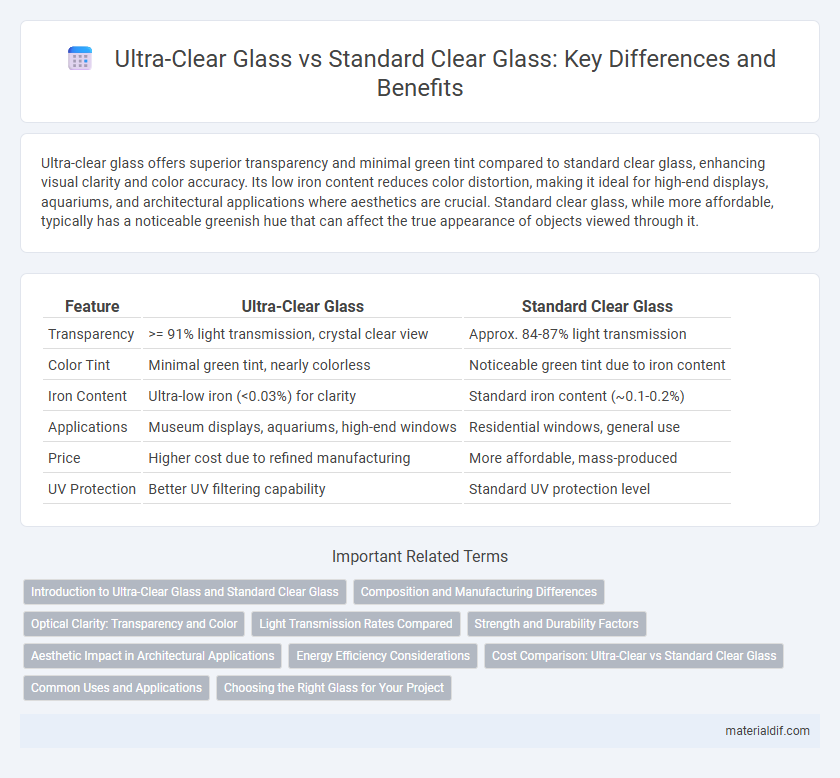Ultra-clear glass offers superior transparency and minimal green tint compared to standard clear glass, enhancing visual clarity and color accuracy. Its low iron content reduces color distortion, making it ideal for high-end displays, aquariums, and architectural applications where aesthetics are crucial. Standard clear glass, while more affordable, typically has a noticeable greenish hue that can affect the true appearance of objects viewed through it.
Table of Comparison
| Feature | Ultra-Clear Glass | Standard Clear Glass |
|---|---|---|
| Transparency | >= 91% light transmission, crystal clear view | Approx. 84-87% light transmission |
| Color Tint | Minimal green tint, nearly colorless | Noticeable green tint due to iron content |
| Iron Content | Ultra-low iron (<0.03%) for clarity | Standard iron content (~0.1-0.2%) |
| Applications | Museum displays, aquariums, high-end windows | Residential windows, general use |
| Price | Higher cost due to refined manufacturing | More affordable, mass-produced |
| UV Protection | Better UV filtering capability | Standard UV protection level |
Introduction to Ultra-Clear Glass and Standard Clear Glass
Ultra-clear glass features a significantly lower iron oxide content compared to standard clear glass, resulting in higher light transmission and minimal green tint, making it ideal for applications requiring exceptional clarity such as display cases and aquariums. Standard clear glass contains more iron oxide, which causes a greenish hue and slightly reduces transparency, commonly used in residential windows and everyday glass products. The difference in iron content leads to variations in visual performance and color accuracy between ultra-clear and standard clear glass.
Composition and Manufacturing Differences
Ultra-clear glass contains a significantly reduced iron oxide content compared to standard clear glass, resulting in higher light transmittance and minimal greenish tint. The manufacturing process of ultra-clear glass involves using low-iron silica sand and precise melting techniques to achieve enhanced clarity and color neutrality. Standard clear glass typically uses conventional silica sand with higher iron levels, producing the characteristic greenish hue and slightly lower transparency.
Optical Clarity: Transparency and Color
Ultra-clear glass offers superior optical clarity compared to standard clear glass, delivering higher transparency and minimal color distortion. This type of glass contains fewer impurities and lower iron content, resulting in a more true-to-life color representation and enhanced light transmission. Standard clear glass typically exhibits a greenish tint due to iron oxide, which can subtly alter the appearance of objects viewed through it.
Light Transmission Rates Compared
Ultra-clear glass offers a light transmission rate of approximately 91%, significantly higher than the 83-86% typically seen in standard clear glass. This enhanced clarity results from a lower iron content, reducing the greenish tint found in standard glass and allowing more natural light to pass through. High light transmission rates make ultra-clear glass ideal for applications requiring maximum brightness and color accuracy, such as in display cases and architectural glazing.
Strength and Durability Factors
Ultra-clear glass features a higher purity level with reduced iron content, enhancing its strength and durability compared to standard clear glass. Its molecular structure offers greater resistance to scratches and impacts, making it ideal for applications requiring long-lasting, robust performance. Standard clear glass, while sufficient for everyday use, tends to be more susceptible to chipping and wear under high-stress conditions.
Aesthetic Impact in Architectural Applications
Ultra-clear glass offers superior optical clarity with minimal green tint, enhancing natural light transmission and providing a more true-to-color view in architectural applications. This heightened transparency significantly elevates a building's aesthetic value by allowing vibrant interior designs and exterior landscapes to be showcased without distortion. Standard clear glass, with its noticeable green hue, may slightly alter color perception and reduce brightness, impacting the overall visual appeal of modern architectural spaces.
Energy Efficiency Considerations
Ultra-clear glass offers superior energy efficiency compared to standard clear glass due to its higher light transmittance and lower iron content, reducing heat absorption and enhancing natural daylight penetration. The reduced solar heat gain coefficient (SHGC) of ultra-clear glass minimizes cooling loads in buildings, leading to significant energy savings. Standard clear glass, with higher iron impurities, tends to absorb more solar radiation, increasing reliance on artificial climate control systems.
Cost Comparison: Ultra-Clear vs Standard Clear Glass
Ultra-clear glass commands a higher price point compared to standard clear glass due to its superior clarity and reduced iron content, which enhances light transmission and color accuracy. The manufacturing process for ultra-clear glass involves more intensive refining techniques, contributing to increased production costs. Despite the premium cost, ultra-clear glass offers long-term value in applications requiring aesthetic precision and enhanced visual quality.
Common Uses and Applications
Ultra-clear glass, known for its high light transmittance and minimal green tint, is commonly used in premium picture frames, museum displays, and high-end storefronts where true color representation is critical. Standard clear glass, featuring a slight green tint and lower clarity, is typically utilized in residential windows, commercial facades, and everyday glass doors where cost-efficiency and general visibility are prioritized. Both types serve distinct market demands, with ultra-clear glass favored for visual accuracy and standard clear glass for broad, functional applications.
Choosing the Right Glass for Your Project
Ultra-clear glass offers superior transparency and minimal green tint compared to standard clear glass, making it ideal for projects requiring true color representation and enhanced light transmission. Standard clear glass is more cost-effective but exhibits a slight greenish hue due to iron content, which can alter the appearance of displayed materials. Selecting ultra-clear glass is essential for high-end architectural applications, display cases, and aquariums where visual clarity and color accuracy are paramount.
Ultra-clear glass vs Standard clear glass Infographic

 materialdif.com
materialdif.com